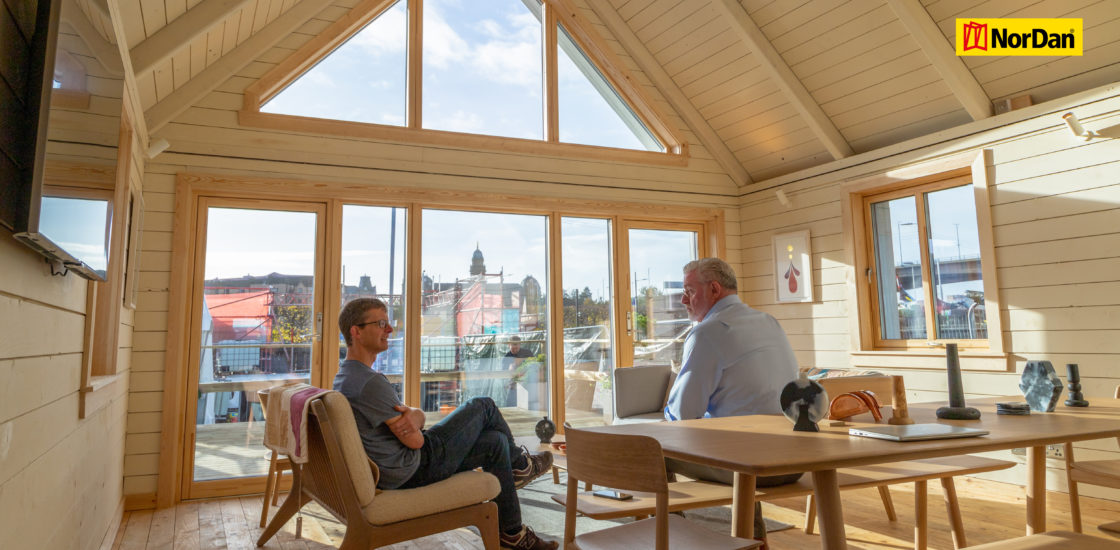
Let’s Make Proposed Embodied Carbon Legislation a Window of Opportunity
By Mike Stevenson, Senior Manager for Strategic Markets at NorDan UK
If we are truly honest with ourselves, the big improvements in the environmental performance of buildings have been driven not from the fear of irreversible climate change, but by the need to comply with new legislation.
The operational carbon efficiency of buildings has come on leaps-and-bounds, benefiting the environment, and of course those who pay for spiralling energy bills.
But these big improvements to operational carbon have only sought to raise the proportional significance and impact of a building’s embodied carbon – so much so that new legislation is on the way.
We’ve long-known about the negative environmental impact of embodied carbon, but in a highly volatile industry, often straightjacketed by fierce competition and tight profit margins, it’s been hard to reconcile short term financial expediency with longer term sustainable thinking.
Improving operational efficiency has certainly had a positive impact on reducing carbon, with new build and retrofitting technology advancing to a point where it has made buildings warmer and dryer.
Embodied carbon on the other hand has become something of an elephant in the room. Until now.
On Wednesday 2nd February Duncan Baker, the MP for North Norfolk presented what could become highly significant legislation.
The Carbon Emissions (Buildings) Bill received its first reading, with a second scheduled for 18th March 2022.
‘The Part Z’ bill will seek to legally recognise and regulate embodied carbon, creating legislation that will factor in the carbon emissions of a building’s whole life.
Having worked over 30 years in the built environment, and having worked across every conceivable window material and design, I and my colleagues at NorDan UK warmly welcome this bill as an overdue step in the right direction.
The bill helps move us to a more honest place, where we face up to the true implications of all the things we do – including how we build buildings and the materials and methods we use to do so.
Construction’s embodied carbon is dangerous and regressive, but can also be radically reduced if we all approach aspects of building differently.
Unlike a building’s operational carbon emissions, which can be improved and reduced with new technologies, once embodied carbon is emitted into the atmosphere, there’s no going back.
We’re now at the point where embodied carbon accounts for around 50% of the total emissions generated in a buildings’ lifetime, and construction accounts for almost 40% of total global carbon emissions.
Put another way: on the day a building is finished you’ve already lost 50% of the chance to reduce its impact on climate change – and that figure in proportion to operational efficiency is only going to get higher if left unchecked.
Regardless of the proposed legislation, in my opinion it’s time for the industry to ask:
- What materials are we building with – Are they truly sustainable? Is there a better alternative that helps to address the climate emergency?
- Whole life cost or capital cost – what is more important?
- And crucially, are we measuring the whole life carbon of the products we use and the decisions we take?
At COP 26 last year I was very clear that sustainable timber has to play a part in reducing embodied carbon.
When grown, harvested, processed and replenished correctly, tree timber is the only truly renewable building material. Carbon negative in growth, the C02 is then safely trapped in the material (a process called sequestration), for the lifetime of that product.
A good example is NorDan’s aluminium-clad timber window and door frames. As well as containing 50% less embodied carbon than PVCU and four-times less carbon than aluminium (according to BSRIA - the Inventory of Carbon and Energy), they also offer a 60-year life span with minimal maintenance. PVCu (fossil fuel based), can only meet half of that.
And here lies the challenge: a longer life-span requires a greater upfront capital investment, so like carbon, the industry must value the whole life cost of a building.
When high quality and sustainable products are given a long enough time to perform, carbon, financial and social sustainability value merge into a single entity.
This is our mission at NorDan – and why we are one of the few window manufacturers that has invested heavily in Environmental Product Declarations (EPD), which means we have third party accredited information on our products from material extraction through to the end-of-life stage.
These EPD’s are freely available to clients, architects, specifiers, contractors and developers to support their respective decision making, and puts NorDan at the forefront of evidenced based carbon data in the construction industry, certainly where fenestration is concerned.
Finally, embodied carbon is an example of how making changes today can have an instant and irreversible positive impact on climate change.
But we have to choose to see problems for what they are, and if we keep specifying the same high-carbon building products based on habit and price, then we will keep getting the same results.
The ‘Part Z’ Carbon Emissions Bill is a positive step in the right direction, but let’s make this a catalyst for permanent change.

I’m Mike Stevenson, the Senior Manager for Strategic Markets at NorDan UK Ltd, with over 30 years’ experience of windows, building and buildings. If you’d value further input or discussion on any of the issues raised in this Blog please email me at Mike.Stevenson@NorDan.co.uk
Find out why we have a Window of Opportunity in construction.

